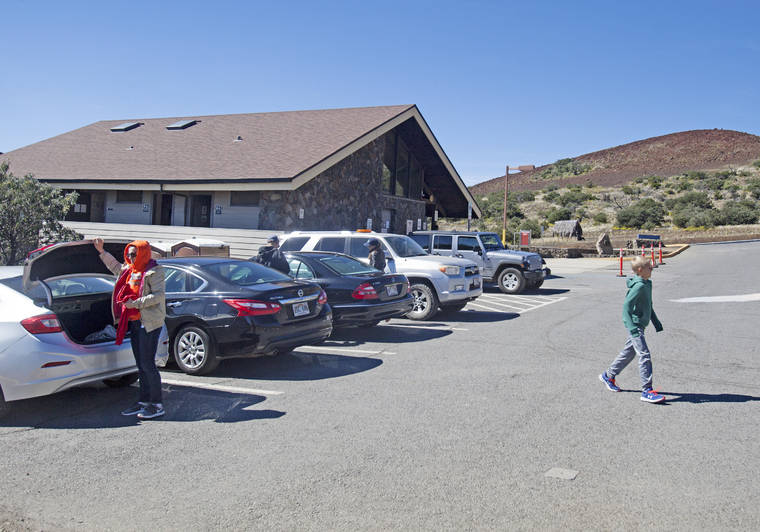The University of Hawaii might develop a regular shuttle service to the top of Maunakea after a proposal for such a program was submitted earlier this week.
During Tuesday’s meeting of the Maunakea Management Board, a pair of Big Island residents discussed with board members a potential pilot program for a daily shuttle to transport visitors from Daniel K. Inouye Highway to the summit, with a stop at the Visitor Information Station halfway up the mountain.
The proposal was developed by Hui Ho‘olako, a nonprofit dedicated to promoting projects in the interest of preserving Hawaiian home lands and “perpetuate Native Hawaiian quality of life and values that dignify life for local Big Island residents and residents of the state of Hawaii.”
Presenting the plan were Hui Ho‘olako representative Pomai Freitas and John McBride, owner of Hawaiian Village Tours.
Under the proposal submitted Tuesday, the service would offer a limited schedule in its first phase, only providing service between the VIS and the summit during the sunset hours, when traffic is typically busiest. The proposal estimated that, based on pre-COVID daily visitor counts, this first phase could replace 47 visitor vehicles with only four shuttle vans.
Subsequent phases would add daytime service between the VIS and the summit, as well as sunset and daytime service between the VIS and the intersection between Daniel K. Inouye Highway and Maunakea Access Road.
The proposal also envisions a fee schedule for the service wherein a passenger could be charged anywhere between $20 and $70 for a round trip, with longer trips during off-peak hours costing less.
The pilot program would last five years, with estimated annual revenues ranging from $410,000-$1.4 million, depending on the phase.
While McBride said the proposal was drafted in only about a month, a possible shuttle service has been a subject of discussion for several years.
Gov. David Ige visited the summit in 2015 and shortly thereafter developed a 10-point plan to improve stewardship of the mountain, which highlighted the need to reduce the impact to the summit environment by limiting the number of vehicles traveling to it.
“We’ve really got to deal with the traffic congestion at the VIS,” said Stephanie Nagata, director of the Office of Maunakea Management, who added that the number of cars at the VIS exceeds the number of parking spaces during peak hours, whereupon drivers park elsewhere such as on the shoulders of Maunakea Access Road or other places unintended for parking.
McBride pointed out that the high level of traffic to the summit is damaging to the environment and the infrastructure.
“You see people taking their rental cars to the summit on two-wheel drive, and what that means is they’re just chewing up the pavement,” McBride said. “And then you have their rental cars breaking down all the time, and they have to get towed.”
While the proposal also suggests the program set a limit on the number of visitors driving themselves to the summit — about 40 vehicles per day during phase 1, for example — it does not suggest how drivers would be blocked from accessing the road on their own.
Two members of the public commented in favor of the proposal, with one pointing out that the service could be beneficial for visitors who suffer from unexpected altitude sickness. For example, if a traveler gets sick at the summit, it would be easier for them to return to lower altitudes by catching the next shuttle rather than forcing their entire carpool to leave.
There are currently seven tour operators licensed to travel to the summit — although Nagata noted that all of them have shut down mountain tours because of the COVID-19 pandemic. Freitas said Hui Ho‘olako is open to allow any one of those operators to participate in the shuttle program.
While the proposal is based on several assumptions — one being that visitor rates to the summit will eventually return to pre-COVID numbers, as well as the resumption of nightly stargazing activities at the VIS — McBride said the uncertain future is ideal for testing a pilot program.
“There’s no better time for a pilot program than right now,” McBride said. “There’s low traffic right now, so we can build a fire that we can control instead of waiting for everyone to come back and being thrown into a fire we can’t control.”
The proposal was met with general support from the board, which recommended to pass the proposal on to the University of Hawaii’s Office of Maunakea Stewardship for policy review.
Email Michael Brestovansky at mbrestovansky@hawaiitribune-herald.com.






